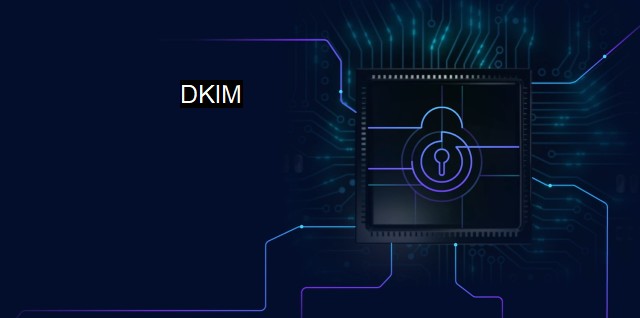What is DKIM?
Ensuring Authenticity and Security: The Vital Role of DKIM in Mitigating Cyber Threats and Maintaining Digital Trust
DomainKeys Identified Mail (DKIM) is an essential technology in the cybersecurity landscape, significantly contributing to the defense mechanisms against email-based threats. This technology brings another layer of protection to system security, reducing the risks of email spoofing – a tactic that cybercriminals often exploit to perpetrate phishing and spamming attacks.DKIM is an open-standard authentication method that allows receiving email systems to check that incoming messages from a specific domain were indeed authorized by the domain's administrators. This exercise is crucial for determining whether the submitted emails are genuine or pose a potential risk.
It was developed to combat a vulnerability in the standard Simple Mail Transfer Protocol (SMTP), which allows any computer to send an email declaring to be anyone. A maliciously minded individual could craft an email pretending to be a bank or another trusted entity and, in turn, deceive recipients, install viruses, or gain personal details. DKIM helps to resolve this risk by tying an email to a domain, thus legitimizing its origin.
DKIM operates by leveraging the power of cryptography. The process involves a digital signature associated with a domain inserted into the header of an outgoing email. A corresponding public key is then listed in the Domain Name System (DNS). When an incoming email is received by an email system with DKIM capability, the implementation validates it by verifying the DKIM signature against the public key. If verified, the recipient can trust that the email came from the domain it declares as its origin.
In DKIM, there's a significant emphasis on the public-private key pairing, which underpins PKI (Public Key Infrastructure) – an enviable backbone of cybersecurity, valued for its ability to secure any form of digital communication. The private key acts as a 'secret' code, which is only kept by the domain sending the email, while the public key is published on the DNS and is available to anyone who wants to verify a message's origin.
The validation process by DKIM significantly minimizes the risk of harmful emails invading an organization's systems and causing an array of potential damages ranging from data theft to tasks disruption. To fully exploit the DKIM strategy, organizations also often combine it with SPF (Sender Policy Framework) and DMARC (Domain-based Message Authentication, Reporting, and Conformance) configurations. This strategy, known as email authentication, is a robust defense mechanism that helps ensure cybercriminals aren't able to exploit emails to carry out their malicious attacks.
While DKIM represents a vital component of cybersecurity due to its enhanced approach to securing email communications, it is not infallible. DKIM doesn't necessarily confirm the email's sender but rather validates the domain it claims to originate from. Consequently, DKIM alone may not entirely prevent phishing attacks or other security breaches.
Regardless, it is essential to understand that implementing DKIM is considered a best practice and provides a strong layer of defense against email impersonation attacks. Adequately deployed, the DomainKeys Identified Mail system can significantly heighten the resilience of an organization to cyber threats, providing a level of assurance to recipients about the legitimacy of the sent email.
In the light of ever-evolving cybersecurity threats, mechanisms like DKIM play a vital role in preventing spoofing tactics and ensuring that email does its job as a safe, trusted communication tool. When DKIM gets combined with other cybersecurity approaches and robust antivirus programs, it becomes part of an effective line of defense, preserving system integrity and maintaining user confidence.

DKIM FAQs
What is DKIM and how does it work?
DKIM stands for DomainKeys Identified Mail. It is a form of email authentication that uses a digital signature to verify the authenticity of an email message. The sender signs outgoing messages with a private key, and the recipient verifies the signature using the public key published in the sender's DNS records.Why is DKIM important for cybersecurity?
DKIM helps prevent email spoofing and phishing attacks by verifying the authenticity of the sender's domain. It ensures that the email message was not tampered with during transmission and that it was indeed sent by a legitimate sender. This helps protect against malware and other cybersecurity threats that can be spread through email.Can antivirus software detect DKIM signatures?
Antivirus software does not typically detect DKIM signatures. Its main purpose is to scan for and remove malware from email messages and attachments. However, some antivirus software may use DKIM as one factor in determining the legitimacy of an email message.Do all email providers support DKIM?
Most major email providers, such as Gmail, Yahoo, and Microsoft, support DKIM. However, it is important to check with your email provider to ensure that DKIM is properly implemented and enabled for your domain. Some email providers may also require additional steps, such as configuring DNS records, in order to properly set up DKIM.Related Topics
Email security SPF (Sender Policy Framework) Email authentication Email spoofing prevention Email encryption
| | A | | | B | | | C | | | D | | | E | | | F | | | G | | | H | | | I | | | J | | | K | | | L | | | M | |
| | N | | | O | | | P | | | Q | | | R | | | S | | | T | | | U | | | V | | | W | | | X | | | Y | | | Z | |
| | 1 | | | 2 | | | 3 | | | 4 | | | 7 | | | 8 | | |||||||